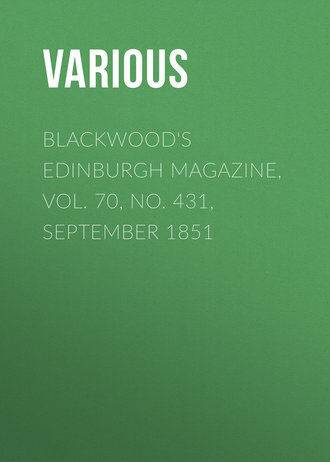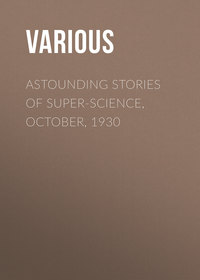 полная версия
полная версияПолная версия
Blackwood's Edinburgh Magazine, Vol. 70, No. 431, September 1851
The institution had by this time been so long regarded as a public show that it was beginning to be regarded as nothing else. Gratuitous lectures, which are always good for nothing, and to which all kinds of people crowd with corresponding profit, were gradually reducing the character of the Jardin; when Cuvier, a man of talent, was appointed to one of the departments of the institution, and he instantly revived its popularity; and, what was of more importance, its public use.
Cuvier devoted himself to comparative anatomy and geology. The former was a study within human means, of which he had the materials round him, and which, being intended for the instruction of man, is evidently intended for his investigation. The latter, in attempting to fix the age of the world, to decide on the process of creation, and to contradict Scripture by the ignorance of man, is merely an instance of the presumption of Sciolism. Cuvier exhibited remarkable dexterity in discovering the species of the fossil fishes, reptiles, and animals. The science was not new, but he threw it into a new form – he made it interesting, and he made it probable. If a large proportion of his supposed discoveries were merely ingenious guesses, they were at least guesses which there was nobody to refute, and they were ingenious– that was enough. Fame followed him, and the lectures of the ingenious theorist were a popular novelty. The "Cabinet of Comparative Anatomy" in the Jardin is the monument of his diligence, and it does honour to the sagacity of his investigation.
One remark, however, must be made. On a former visit to the Cabinet of Comparative Anatomy, among the collection of skeletons, I was surprised and disgusted with the sight of the skeleton of the Arab who killed General Kleber in Egypt. The Arab was impaled, and the iron spike was shown still sticking in the spine! I do not know whether this hideous object is still to be seen, for I have not lately visited the apartment; but, if existing still, it ought to remain no longer in a museum of science. Of course, the assassin deserved death; but, in all probability, the murder which made him guilty, was of the same order as that which made Charlotte Corday famous. How many of his countrymen had died by the soldiery of France! In the eye of Christianity, this is no palliation; though in the eye of Mahometanism it might constitute a patriot and a hero. At all events, so frightful a spectacle ought not to meet the public eye.
Hôtel des Invalides.– The depository of all that remains of Napoleon, the monument of almost two hundred years of war, and the burial-place of a whole host of celebrated names, is well worth the visit of strangers; and I entered the esplanade of the famous hôtel with due veneration, and some slight curiosity to see the changes of time. I had visited this noble pile immediately after the fall of Napoleon, and while it still retained the honours of an imperial edifice. Its courts now appeared to me comparatively desolate; this, however, may be accounted for by the cessation of those wars which peopled them with military mutilation. The establishment was calculated to provide for five thousand men; and, at that period, probably, it was always full. At present, scarcely more than half the number are under its roof; and, as even the Algerine war is reduced to skirmishes with the mountaineers of the Atlas, that number must be further diminishing from year to year.
The Cupola then shone with gilding. This was the work of Napoleon, who had a stately eye for the ornament of his imperial city. The cupola of the Invalides thus glittered above all the roofs of Paris, and was seen glittering to an immense distance. It might be taken for the dedication of the French capital to the genius of War. This gilding is now worn off practically, as well as metaphorically, and the prestige is lost.
The celebrated Edmund Burke, all whose ideas were grand, is said to have proposed gilding the cupola of St Paul's, which certainly would have been a splendid sight, and would have thrown a look of stateliness over that city to which the ends of the earth turn their eyes. But the civic spirit was not equal to the idea, and it has since gone on lavishing ten times the money on the embellishment of lanes.
The Chapel of the Invalides looked gloomy, and even neglected; the great Magician was gone. Some service was performing, as it is in the Romish chapels at most hours of the day: some poor people were kneeling in different parts of the area; and some strangers were, like myself, wandering along the nave, looking at the monuments to the fallen military names of France. On the pillars in the nave are inscriptions to the memory of Jourdan, Lobau, and Oudinot. There is a bronze tablet to the memory of Marshal Mortier, who was killed by Fieschi's infernal machine, beside Louis Philippe; and to Damremont, who fell in Algiers.
But the chapel is destined to exhibit a more superb instance of national recollection – the tomb of Napoleon, which is to be finished in 1852. A large circular crypt, dug in the centre of the second chapel (which is to be united with the first,) is the site of the sarcophagus in which the remains of Napoleon lie. Coryatides, columns, and bas-reliefs, commemorative of his battles, are to surround the sarcophagus. The coryatides are to represent War, Legislation, Art, and Science; and in front is to be raised an altar of black marble. The architect is Visconti, and the best statuaries in Paris are to contribute the decorations. The expense will be enormous. In the time of Louis Philippe it had already amounted to nearly four millions of francs. About three millions more are now demanded for the completion, including an equestrian statue. On the whole, the expense will be not much less than seven millions of francs!
The original folly of the nation, and of Napoleon, in plundering the Continent of statues and pictures, inevitably led to retribution, on the first reverse of fortune. The plunder of money, or of arms, or of anything consumable, would have been exempt from this mortification; but pictures and statues are permanent things, and always capable of being re-demanded. Their plunder was an extension of the law of spoil unknown in European hostilities, or in history, except perhaps in the old Roman ravage of Greece. Napoleon, in adopting the practice of heathenism for his model, and the French nation – in their assumed love of the arts violating the sanctities of art, by removing the noblest works from the edifices for which they were created, and from the lights and positions for which the great artists of Italy designed them – fully deserved the vexation of seeing them thus carried back to their original cities. The moral will, it is to be presumed, be learned from this signal example, that the works of genius are naturally exempt from the sweep of plunder; that even the violences of war must not be extended beyond the necessities of conquest; and that an act of injustice is sure to bring down its punishment in the most painful form of retribution.
The Artesian Well.– Near the Hôtel des Invalides is the celebrated well which has given the name to all the modern experiments of boring to great depths for water. The name of Artesian is said to be taken from the province of Artois, in which the practice has been long known. The want of water in Paris induced a M. Mulot to commence the work in 1834.
The history of the process is instructive. For six years there was no prospect of success; yet M. Mulot gallantly persevered. All was inexorable chalk; the boring instrument had broken several times, and the difficulty thus occasioned may be imagined from its requiring a length of thirteen hundred feet! even in an early period of the operation. However, early in 1841 the chalk gave signs of change, and a greenish sand was drawn up. On the 26th of February this was followed by a slight effusion of water, and before night the stream burst up to the mouth of the excavation, which was now eighteen hundred feet in depth. Yet the water rapidly rose to a height of one hundred and twelve feet above the mouth of the well by a pipe, which is now supported by scaffolding, giving about six hundred gallons of water a minute.
Even the memorable experiment confutes, so far as it goes, the geological notion of strata laid under each other in their proportions of gravity. The section of the boring shows chalk, sand, gravel, shells, &c., and this order sometimes reversed, in the most casual manner, down to a depth five times the height of the cupola of the Invalides.
The heat of the water was 83° of Fahrenheit. In the theories with which the philosophers of the Continent have to feed their imaginations is that of a central fire, which is felt through all the strata, and which warms everything in proportion to its nearness to the centre. Thus, it was proposed to dig an Artesian well of three thousand feet, for the supply of hot water to the Jardin des Plantes and the neighbouring hospitals. It was supposed that, at this depth, the heat would range to upwards of 100° of Fahrenheit. But nothing has been done. Even the Well of Grenelle has rather disappointed the public expectation; of late the supply has been less constant, and the boring is to be renewed to a depth of two thousand feet.
The Napoleon Column.– This is the grand feature of the Place de Vendôme, once the site of the Hôtel Vendôme, built by the son of Henry IV. and Gabrielle d'Estrées; afterwards pulled down by Louis XIV., afterwards abandoned to the citizens, and afterwards surrounded, as it is at this day, with the formal and heavy architecture of Mansard. The "Place" has, like everything in Paris, changed its name from time to time. It was once the "Place des Conquêtes;" then it changed to "Louis le Grand;" and then it returned to the name of its original proprietor. An old figure of the "Great King," in all the glories of wig and feathers, stood in the centre, till justice and the rabble of the Revolution broke it down, in the first "energies" of Republicanism. But the German campaign of 1805 put all the nation in good humour, and the Napoleon Column was raised on the site of the dilapidated monarch.
The design of the column is not original, for it is taken from the Trajan Column at Rome; but it is enlarged, and makes a very handsome object. When I first saw it, its decorations were in peril; for the Austrian soldiery were loud for its demolition, or at least for stripping off its bronze bas-reliefs, they representing their successive defeats in that ignominious campaign which, in three months from Boulogne, finished by the capture of Vienna. The Austrian troops, however, stoutly retrieved their disasters, and, as the proof, were then masters of Paris. It was possibly this effective feeling that prevailed at last to spare the column, which the practice of the French armies would have entitled them to strip without mercy.
In the first instance, a statue of Napoleon, as emperor, stood on the summit of the pillar. This statue had its revolutions too, for it was melted down at the restoration of the Bourbons, to make a part of the equestrian statue of Henry IV. erected on the Pont Neuf. A fleur-de-lis and flagstaff then took its place. The Revolution of 1830, which elevated Louis Philippe to a temporary throne, raised the statue of Napoleon to an elevation perhaps as temporary.
It was the shortsighted policy of the new monarch to mingle royal power with "republican institutions." He thus introduced the tricolor once more, sent for Napoleon's remains to St Helena by permission of England, and erected his statue in the old "chapeau et redingote gris," the characteristics of his soldiership. The statue was inaugurated on one of the "three glorious days," in July 1833, in all the pomp of royalty, – princes, ministers, and troops. So much for the consistency of a brother of the Bourbon. The pageant passed away, and the sacrifice to popularity was made without obtaining the fruits. Louis Philippe disappeared from the scene before the fall of the curtain; and, as if to render his catastrophe more complete, he not merely left a republic behind him, but he lived to see the "prisoner of Ham" the president of that republic.
How does it happen that an Englishman in France cannot stir a single step, hear a single word, or see a single face, without the conviction that he has landed among a people as far from him in all their feelings, habits, and nature, as if they were engendered in the moon? The feelings with which the Briton looks on the statue of Buonaparte may be mixed enough: he may acknowledge him for a great soldier, as well as a great knave – a great monarch, as well as a little intriguer – a mighty ruler of men, who would have made an adroit waiter at a table d'hôte in the Palais Royal. But he never would have imagined him into a sentimentalist, a shepherd, a Corydon, to be hung round with pastoral garlands; an opera hero, to delight in the sixpenny tribute of bouquets from the galleries.
Yet I found the image of this man of terror and mystery – this ravager of Europe – this stern, fierce, and subtle master of havoc, decorated like a milliner's shop, or the tombs of the citizen shopkeepers in the cemeteries, with garlands of all sizes! – the large to express copious sorrow, the smaller to express diminished anguish, and the smallest, like a visiting card, for simply leaving their compliments; and all this in the face of the people who once feared to look in his face, and followed his car as if it bore the Thunder!
To this spot came the people to offer up their sixpenny homage – to this spot came processions of all kinds, to declare their republican love for the darkest despot of European memory, to sing a stave, to walk heroically round the railing, hang up their garlands, and then, having done their duty in the presence of their own grisettes, in the face of Paris, and to the admiration of Europe, march home, and ponder upon the glories of the day!
As a work of imperial magnificence, the column is worthy of its founder, and of the only redeeming point of his character – his zeal for the ornament of Paris. It is a monument to the military successes of the Empire; a trophy one hundred and thirty-five feet high, covered with the representations of French victory over the Austrians and Russians in the campaign of 1805. The bas-reliefs are in bronze, rising in a continued spiral round the column. Yet this is an unfortunate sacrifice to the imitation of the Roman column. The spiral, a few feet above the head of the spectator, offers nothing to the eye but a roll of rough bronze; the figures are wholly and necessarily undistinguishable. The only portion of those castings which directly meets the eye is unfortunately given up to the mere uniforms, caps, and arms of the combatants. This is the pedestal, and it would make a showy decoration for a tailor's window. It is a clever work of the furnace, but a miserable one of invention.
The bronze is said to have been the captured cannon of the enemy. On the massive bronze door is the inscription in Latin: – "Napoleon, Emperor, Augustus, dedicated to the glory of the Grand Army this memorial of the German War, finished in three months, in the year 1805, under his command."
On the summit stands the statue of Napoleon, to which, and its changes, I have adverted already. But the question has arisen, whether there is not an error in taste in placing the statue of an individual at a height which precludes the view of his features. This has been made an objection to the handsome Nelson Pillar in Trafalgar Square. But the obvious answer in both instances is, that the object is not merely the sight of the features, but the perfection of the memorial; that the pillar is the true monument, and the statue only an accessory, though the most suitable accessory. But even then the statue is not altogether inexpressive. We can see the figure and the costume of Napoleon nearly as well as they could be seen from the balcony of the Tuilleries, where all Paris assembled in the Carousel to worship him on Sundays, at the parade of "La Garde." In the spirited statue of Nelson we can recognise the figure as well as if we were gazing at him within a hundred yards in any other direction. It is true that pillars are not painters' easels, nor is Trafalgar Square a sculptor's yard; but the real question turns on the effect of the whole. If the pillar makes the monument, we will not quarrel with the sculptor for its not making a miniature. It answers its purpose – it is a noble one; it gives a national record of great events, and it realises, invigorates, and consecrates them by the images of the men by whom they were achieved.
Arc de Triomphe de l'Etoile.– It is no small adventure, in a burning day of a French summer, to walk the length of the Champs Elysées, even to see the arch of the Star, (Napoleon's Star,) and climb to its summit. Yet this labour I accomplished with the fervour and the fatigue of a pilgrimage.
Why should the name of Republic be ever heard in the mouth of a Frenchman? All the objects of his glory in the Capital of which he glories, everything that he can show to the stranger – everything that he recounts, standing on tip-toe, and looking down on the whole world besides – is the work of monarchy! The grand Republic left nothing behind but the guillotine. The Bourbons and Buonapartes were the creators of all to which he points, with an exaltation that throws earth into the shade from the Alps to the Andes. The Louvre, the Madeleine, the Tuilleries, the Hôtel de Ville, (now magnified and renovated into the most stately of town-houses,) the Hôtel des Invalides, Nôtre Dame, &c. &c. are all the work of Kings. If Napoleon had lived half a century longer, he would have made Paris a second Babylon. If the very clever President, who has hitherto managed France so dexterously, and whose name so curiously combines the monarchy and the despotism, – if Louis Napoleon (a name which an old Roman would have pronounced an omen) should manage it into a Monarchy, we shall probably see Paris crowded with superb public edifices.
The kings of France were peculiarly magnificent in the decoration of the entrances to their city. As no power on earth can prevent the French from crowding into hovels, from living ten families in one house, and from appending to their cities the most miserable, ragged, and forlorn-looking suburbs on the globe, the monarchs wisely let the national habits alone; and resolved, if the suburbs must be abandoned to the popular fondness for the wigwam, to impress strangers with the stateliness of their gates. The Arc de St Denis, once conducting from the most dismal of suburbs, is one of the finest portals in Paris, or in any European city; it is worthy of the Boulevard, and that is panegyric at once. Every one knows that it was erected in honour of the short-lived inroad of Louis XIV. into Holland in 1672, and the taking of whole muster-rolls of forts and villages, left at his mercy, ungarrisoned and unprovisioned, by the Republican parsimony of the Dutch, till a princely defender arose, and the young Stadtholder sent back the coxcomb monarch faster than he came. But the Arc is a noble work, and its architecture might well set a redeeming example to the London improvers. Why not erect an arch in Southwark? Why not at all the great avenues to the capital? Why not, instead of leaving this task to the caprices, or even to the bad taste of the railway companies, make it a branch of the operations of the Woods and Forests, and ennoble all the entrances of the mightiest capital of earthly empire?
The Arch of St Denis is now shining in all the novelty of reparation, for it was restored so lately as last year. In this quarter, which has been always of a stormy temperature, the insurrection of 1848 raged with especial fury; and if the spirits of the great ever hover about their monuments, Louis XIV. may have seen from its summit a more desperate conflict than ever figured on its bas-reliefs.
On the Arch of the Porte St Martin is a minor monument to minor triumphs, but a handsome one. Louis XIV. is still the hero. The "Grand Monarque" is exhibited as Hercules with his club; but as even a monarch in those days was nothing without his wig, Hercules exhibits a huge mass of curls of the most courtly dimensions – he might pass for the presiding deity of perruquiers.
The Arc de Triomphe du Carousel, erected in honour of the German campaign in 1805, is a costly performance, yet poor-looking, from its position in the centre of lofty buildings. What effect can an isolated arch, of but five-and-forty feet high, have in the immediate vicinity of masses of building, perhaps a hundred feet high? Its aspect is consequently meagre; and its being placed in the centre of a court makes it look useless, and, of course, ridiculous. On the summit is a figure of War, or Victory, in a chariot, with four bronze horses – the horses modelled from the four Constantinopolitan horses brought by the French from Venice, as part of the plunder of that luckless city, but sent back to Venice by the Allies in 1815. The design of the arch was from that of Severus, in Rome: this secured, at least, elegance in its construction; but the position is fatal to dignity.
The Arc de l'Etoile is the finest work of the kind in Paris. It has the advantage of being built on an elevation, from which it overlooks the whole city, with no building of any magnitude in its vicinity; and is seen from a considerable distance on all the roads leading to the capital. Its cost was excessive for a work of mere ornament, and is said to have amounted to nearly half a million sterling!
As I stood glancing over the groups on the friezes and faces of this great monument, which exhibit war in every form of conflict, havoc, and victory, the homely thought of "cui bono?" struck me irresistibly. Who was the better for all this havoc? – Napoleon, whom it sent to a dungeon! or the miserable thousands and tens of thousands whom it crushed in the field? – or the perhaps more unfortunate hundreds of thousands whom it sent to the hospital, to die the slow death of exhaustion and pain, or to live the protracted life of mutilation? I have no affectation of sentiment at the sight of the soldier's grave; he has but taken his share of the common lot, with perhaps the advantage, which so few men possess, of having "done the state some service." But, to see this vast monument covered with the emblems of hostilities, continued through almost a quarter of a century, (for the groups commence with 1792;) to think of the devastation of the fairest countries of Europe, of which these hostilities were the cause; and to know the utter fruitlessness and failure of the result, the short-lived nature of the triumph, and the frightful depth of the defeat – Napoleon in ignominious bondage and hopeless banishment – Napoleon, after having lorded it over Europe, sent to linger out life on a rock in the centre of the ocean – the leader of military millions kept under the eye of a British sentinel, and no more suffered to stray beyond his bounds than a caged tiger – I felt as if the object before me was less a trophy than a tomb, less a monument of glory than of retribution, less the record of national triumph than of national frenzy.
I had full liberty for reflection, for there was scarcely a human being to interrupt me. The bustle of the capital did not reach so far, the promenaders in the Champs Elysées did not venture here; the showy equipages of the Parisian "nouveaux riches" remained where the crowd was to be seen; and except a few peasants going on their avocations, and a bench full of soldiers, sleeping or smoking away the weariness of the hour, the Arc de Triomphe, which had cost so much treasure, and was the record of so much blood, seemed to be totally forgotten. I question, if there had been a decree of the Legislature to sell the stones, whether it would have occasioned more than a paragraph in the Journal des Debats.
The ascent to the summit is by a long succession of dark and winding steps, for which a lamp is lighted by the porter; but the view from the parapet repays the trouble of the ascent. The whole basin in which Paris lies is spread out before the eye. The city is seen in the centre of a valley, surrounded on every side by a circle of low hills, sheeted with dark masses of wood. It was probably once the bed of a lake, in which the site of the city was an island. All the suburb villages came within the view, with the fortifications, which to a more scientific eye might appear formidable, but which to mine appeared mere dots in the vast landscape.











